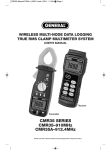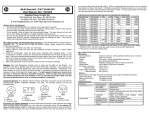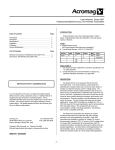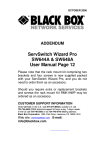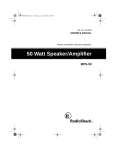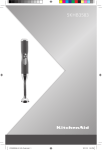Download ac circuit breaker finder bf10 - General Tools And Instruments
Transcript
BF10-Manual_FINAL4-082012_awb 8/20/12 10:31 AM Page 1 AC CIRCUIT BREAKER FINDER USER’S MANUAL BF10 Please read this manual carefully and thoroughly before using this product. BF10-Manual_FINAL4-082012_awb 8/20/12 10:31 AM Page 2 TABLE OF CONTENTS Introduction . . . . . . . . . . . . . . . . . . . . . . . . . . . . 3 – 4 Key Features . . . . . . . . . . . . . . . . . . . . . . . . . . . 4 – 5 Safety Instructions . . . . . . . . . . . . . . . . . . . . . . . . . . 5 What’s in the Blister Pack . . . . . . . . . . . . . . . . . . . . 5 Product Overview . . . . . . . . . . . . . . . . . . . . . . . . . . . 6 Operating Instructions . . . . . . . . . . . . . . . . . . . . 7 – 8 Specifications . . . . . . . . . . . . . . . . . . . . . . . . . . . . . . 9 Changing the Battery . . . . . . . . . . . . . . . . . . . . . . . 10 Warranty Information . . . . . . . . . . . . . . . . . . . 10 – 11 Return for Repair Policy . . . . . . . . . . . . . . . . . 11 – 12 2 BF10-Manual_FINAL4-082012_awb 8/20/12 10:31 AM Page 3 INTRODUCTION Thank you for purchasing General Tools & Instruments’ (General’s) BF10 AC Circuit Breaker Finder. Please read this manual carefully and thoroughly before using the product. The BF10 can perform two functions: 1. Automatically identify the circuit breaker or fuse associated with any 110V outlet without tripping the breaker or blowing the fuse 2. Identify five common receptacle wiring faults The AC Circuit Breaker Finder has two components—an ACpowered transmitter and a battery-powered receiver. When the transmitter is plugged into an AC outlet, it powers on and sends a signal down the branch circuit all the way to the circuit breaker panel. If the tip of the battery-powered receiver is then used to “scan” all of the panel’s breakers (in other words, touch each one in turn), a sensor in the tip will light a green LED on the front of the receiver each time it detects a signal. If no signal is detected, a red LED will light. A first scan will cause the green LED to light several times if the transmitter’s signal has leaked onto adjacent branch circuits. On a rare occasion a second scan may be needed. During each scan, the BF10 uses a patented circuit that automatically adjusts the sensitivity of the sensor to rule out weaker signals representing “false positives.” 3 BF10-Manual_FINAL4-082012_awb 8/20/12 10:31 AM Page 4 The plug-in transmitter also doubles as a socket tester. By measuring leakage currents, it can identify five common outlet wiring faults: missing earth (ground), missing neutral, live and earth reversed, live and neutral reversed, and open circuit. The type of fault is indicated by a unique pattern of colored LEDs on the front of the transmitter as well as the pulsed tone that it emits. The BF10 is NOT a comprehensive diagnostic instrument: • It cannot test the ground fault circuit interruption function of GFCI receptacles. • It cannot measure the quality of earth (ground) connections, detect two hot wires or more than one fault in a circuit, or detect reversed grounded and grounding conductors. The BF10 is a simple instrument for detecting common improper wiring of GFCI and non-GFCI outlets. All detected problems should be referred to a qualified electrician. If you need a comprehensive diagnostic instrument, General recommends its CA10 Circuit Analyzer. For details, visit www.generaltools.com and enter “CA10” in the SEARCH box. KEY FEATURES • Automatically locates the breaker or fuse associated with any 110V outlet without tripping the breaker or blowing the fuse • Also identifies five common outlet wiring faults 4 BF10-Manual_FINAL4-082012_awb 8/20/12 10:31 AM Page 5 • CAT II 600V, CAT III 300V, double-insulated • Built-in flashlight for use in dark areas • Compatible with GFCI receptacles • Audible tone and visual (LED) indications • Low battery warning • Complies with safety standard IEC 61010-1 • Includes “9V” receiver battery SAFETY INSTRUCTIONS ! ! WARNING! Exercise caution when working around circuit breaker panels. Do not use this instrument on circuits with voltages higher than 110V. WHAT’S IN THE BLISTER PACK The BF10’s transmitter and receiver come in a blister pack along with a “9V” battery (pre-installed in the receiver) and this user’s manual. 5 BF10-Manual_FINAL4-082012_awb 8/20/12 10:31 AM Page 6 PRODUCT OVERVIEW Fig. 1 shows the controls, indicators and physical features of the BF10’s transmitter and receiver. Familiarize yourself with their names and functions before moving on to the Operating Instructions Fig. 1. The controls, indicators and physical features of the BF10 D A. Function switch C B. Socket test indicator lights C. Flashlight (on underside) E D. Tip with sensor F E. Yellow “low battery” LED G F. Green “breaker found” LED G. Red “breaker not found” LED H H. Power on/off button I. Flashlight on/off button B I J. Battery compartment (on back) J Fig. 1 6 A BF10-Manual_FINAL4-082012_awb 8/20/12 10:31 AM Page 7 OPERATING INSTRUCTIONS Before plugging the BF10 transmitter into either kind of branch circuit receptacle (GFCI or non-GFCI), unplug all appliances and equipment connected to that circuit. If you're not sure whether an appliance or a piece of equipment is powered by the circuit to be tested, unplug it to err on the side of caution. Then plug in the transmitter. To check a 110V GFCI or non-GFCI outlet for wiring faults, slide the function switch on the transmitter (Fig. 1, Callout A) to the right (the Socket Test position). • If the outlet has no wiring faults, the two green LEDs in the top row of socket test indicator lights will illuminate (turn on) and a continuous tone will be heard. • If the outlet has an open circuit or is not powered, no LEDs will illuminate and no tone will be heard (because the transmitter will remain unpowered). • If the outlet has any of four common wiring faults (missing earth (ground), missing neutral, live and earth reversed, and live and neutral reversed), a unique pattern of one or more green LEDs, or green and red LEDs, particular to that fault will be displayed and a pulsed tone will be heard. Labels to the right of the LEDs indicate which fault has been detected. 7 BF10-Manual_FINAL4-082012_awb 8/20/12 10:31 AM Page 8 To identify the breaker or fuse associated with the branch circuit the transmitter is plugged into: 1. Slide the function switch on the transmitter to the left (the Breaker Find position). 2. Go to the circuit breaker panel and begin scanning breakers by touching the tip of the receiver to each breaker in turn. If the panel is in a dark area, turn on the built-in flashlight (Fig. 1, Callout C) by pressing the button (Callout I). Touching breakers will cause the red LED on the receiver (Fig. 1, Callout G) to light but at least one breaker will cause the green LED on the receiver (Fig. 1, Callout F) to light. If only one breaker causes the green LED to light, that breaker is the one associated with the outlet that the transmitter is plugged into. 3. If more than one breaker caused the green LED to light, scan all breakers in the panel again. If doing so causes the green LED to light just once, the breaker that “tested positive” is the breaker associated with the outlet that the transmitter is plugged into. 4. If the second scan lights the green LED more than once, scan all the breakers a third time. A third scan will always light the green LED on the receiver just once. The breaker that tested positive is the one associated with the outlet that the transmitter is plugged into. 8 BF10-Manual_FINAL4-082012_awb 8/20/12 10:31 AM Page 9 SPECIFICATIONS Socket Wiring Indications Operating Temperature Dimensions Weight Power Source Certifications Correct wiring Missing earth (ground) Missing neutral Live & earth reversed Live & neutral reversed Open circuit 32° to 122°F (0° to 50°C) Transmitter: 2.8 x 2.5 x 2.3 in. (71 x 64 x 58mm) Receiver: 7.4 x 1.8 x 1.5 in. (188 x 46 x 38mm) Transmitter: 2.1 oz. (60g) Receiver: 4.3 oz. (122g) 1 “9V” battery for receiver (included) CAT II 600V, CAT III 300V CE RoHS Safety standard IEC 61010-1 9 BF10-Manual_FINAL4-082012_awb 8/20/12 10:31 AM Page 10 CHANGING THE BATTERY When the yellow LED on the receiver (Fig. 1, Callout E) illuminates, it’s time to change the battery. The battery compartment (Callout J) is accessible from the back of the receiver. To replace the battery: 1. Open the compartment by loosening and removing the single Phillips-head screw securing the compartment cover to the bottom of the receiver. Remove the screw and cover and set them aside. 2. Remove the old battery and plug a fresh “9V” battery into the wired socket inside the compartment. The terminals of the battery and the socket mate in only one way, with the smaller male terminal plugging into the larger female terminal. 3. Replace the battery compartment cover and secure it to the back of the receiver with the Philips-head screw. WARRANTY INFORMATION General Tools & Instruments’ (General’s) BF10 AC Circuit Breaker Finder is warranted to the original purchaser to be free from defects in material and workmanship for a period of one year. Subject to certain restrictions, General will repair or 10 BF10-Manual_FINAL4-082012_awb 8/20/12 10:31 AM Page 11 replace this instrument if, after examination, the company determines it to be defective in material or workmanship. This warranty does not apply to damages that General determines to be from an attempted repair by non-authorized personnel or misuse, alterations, normal wear and tear, or accidental damage. The defective unit must be returned to General Tools & Instruments or to a General-authorized service center, freight prepaid and insured. Acceptance of the exclusive repair and replacement remedies described herein is a condition of the contract for purchase of this product. In no event shall General be liable for any incidental, special, consequential or punitive damages, or for any cost, attorneys’ fees, expenses, or losses alleged to be a consequence of damage due to failure of, or defect in any product including, but not limited to, any claims for loss of profits. RETURN FOR REPAIR POLICY Every effort has been made to provide you with a reliable product of superior quality. However, in the event your instrument requires repair, please contact our Customer Service to obtain an RGA (Return Goods Authorization) number before forwarding the unit via prepaid freight to the attention of our Service Center at this address: 11 BF10-Manual_FINAL4-082012_awb 8/20/12 10:31 AM Page 12 General Tools & Instruments 80 White Street New York, NY 10013 212-431-6100 Remember to include a copy of your proof of purchase, your return address, and your phone number and/or e-mail address. GENERAL TOOLS & INSTRUMENTS 80 White Street New York, NY 10013-3567 PHONE (212) 431-6100 FAX (212) 431-6499 TOLL FREE (800) 697-8665 e-mail: [email protected] www.generaltools.com BF10 User’s Manual Specifications subject to change without notice ©2012 GENERAL TOOLS & INSTRUMENTS NOTICE - WE ARE NOT RESPONSIBLE FOR TYPOGRAPHICAL ERRORS. BF10 8/18/12












